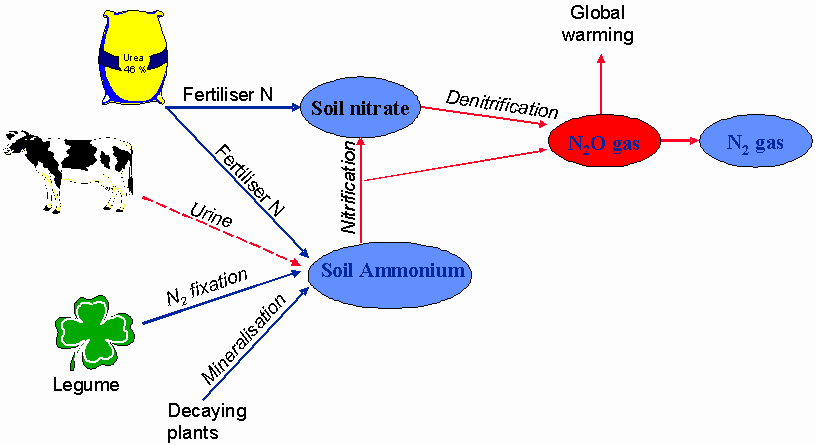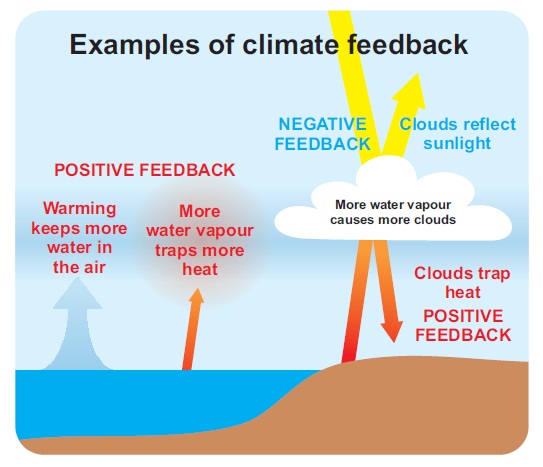The Greenhouse effect is a process by which thermal radiation from the earths surface is absorbed by the atmospheric green house gases and is re- radiated in all directions. Some parts of this re- radiation is reflected back towards the surface and the lower atmosphere.

The wavelengths of visible light from the sun passes through a transparent medium and are observed, but the longer wavelengths of the infra red re-radiation from the heated objects are unable to pass through that medium. The trapping of long wavelength radiation leads to more heating and a higher resultant temperature. The medium of gases are called "Green house gases" and the efffect is called "Green house effect".
The atmosphere has a number of gases often in tiny amounts, which trap the heat given out by the earth.
To make sure that the atmospheric temperature remains constant, the balance of these gases in the atmosphere must not be upset.

The Green house gases are
The proportion of the above mentioned gases should not change, but due to some of the human activities it is tend to change.
Carbon di oxide:
- Increase in the population is one of the cause for increase in green house gases. Due to over population, we cut down lot of trees for shelter, firewood, furniture etc., this activity increases the level of carbon di oxide in the atmosphere.
- As we know trees play a major role in balancing the atmospheric gases, during day time it releases oxygen and takes carbon di oxide and in night it takes oxygen and releases carbon di oxide.
- Cutting down the trees reduces the required rainfall and causes draught, as well as lowers the underground water level and alters the water vapour level present in atmosphere.
- Carbon di oxide is produced by burning of fossils fuel and trophical deforestration. Measeurements of co2 from the Mauna Loa observatory shows that concentration have increased from about 313ppm in 1960 to about 389ppm in 2010.
- Burning of fossil fuel for heating, power generation and transport, as well as some industrial processes such as cement making produces carbon emission.
Methane:
- Methane reacts with atmospheric oxygen and breakdown into carbon di oxide and water . CH4+2O2----> CO2+ 2H2O.
- Cows and sheep contains bacteria in their gastero intestinal system that help to breakdown plant material. Some of these micro organisms use the acetate from the plant material to produce methane, and because these bacteria live in the stomach and intestines, whenever the animal defecates, it emits methane gas.
- Population is increasing day by day and the requirement of the food is also in the same level. In major countries rice is the main source for food. So, it is cultivated in many parts of the world, this rice crop is a major cause for methane emission.
- Waste water recycling is common in most of the industries; during this process they remove organic matter, solids, pathogens and chemical hazards. methane gas emits as a result of this process.
- Methane emission occurs during the incomplete burning of plants animals and organic matters. Wild fire, burning by civilians to clear out lands and burning to destroy waste.
Nitrous oxide:

- Nitrous oxide is naturally present in the atmosphere as part of the earths nitrogen cycle, and as a variety of natural sources. however, human activities such as agriculture, fossil fuel combustion, waste water management and industrial process are increasing the amount of N2O in the atmosphere.
- Nitrous oxide is emitted when people add nitrogen to the soil through the use of synthetic fertilizers. agricultural soil management is the largest source of N2O emission.
- Nitrous oxide is emitted when transportation fuels are burnt. Motor vehicles including passenger cars and trucks, are the primary source of N2O emissions from transportation.
- Nitrous oxide is generated as a bi product during the production of nitric acid, which is used to make synthetic commerical fertilizer, and in the production of adipic acid, which is used to make fibers, like nylon, and other synthetic products.
Ozone:

- Ozone protects us from the harmful UV radiations from the sun. It filters out all the radiations. any depletion of ozone would, therefore, have catastrophic effects on life systems of the earth. Major pollutants responsible for this depletion are CFC, nitrogen oxides and hydro carbons.
- CFCs are widely used as coolents in the air conditioners and refrigerators, cleaning solvents, aerosol propulants and in foam insulation. CFC is also used in fire extinguishing equipment. that escapes as aerosol in the statosphere.
- Depletion of ozone in stratosphere causes direct as well as indirect harmful effects. since the temperature raise in stratosphere is due to heat absorption by ozone, the reduction in ozone would lead to temperature changes and rainfall failures on earth.
Water Vapour:

- Water Vapour's role in the earth's climate system is defined by the very short time it remains in the atmosphere and actively traps heat.
- The concentration of water vapour in the atmosphere is in equilibrium.The atmosphere can only hold more water vapour if overall temperature increase.so a small warming effects caused by human CO2 emissions will increase the amount of water vapour in the atmosphere.
- As the temperature of the atmosphere rises,more water is evaporated from ground storage(rivers,oceans,reservoirs,soil).Because the air is warmer,the relative humidity can be higher leading to more water vapour in the atmosphere.
- As a greenhouse gas,the higher concentration of water vapour is then able to absorb more thermal IR energy radiated from the earth,thus further warming the atmosphere.
Effects of increase in green house gases:
- Due to the heat trap the surface temperature of the earth increases gradually causing the global warming.
- Global warming will decrease snow, sea ice and glacier coverage, resluting in rising sea levels and increased coastal flooding. Rising temperature will also thaw permafrost in the artic.
- Stroms and heat waves are likely to increase in frequency and severity. Many wild species will ahve difficulty adapting to a warmer climate and will likely experience greater stress from diseases and invasive species.
- Increased temperature and more frequent and severe extreme weather events could lead to increased risks of death from dehydration and heat stroke and injuries from intense local weather changes.
- There may be an increased risk of respiratory and cardiovascular problems and certain types of cancers as temperature rise and exacerbate air pollution.
- Agriculture, forestry, tourism and recreation could be affected by changing weather patterns.
How to avoid green house effect:
- By using carbon less and carbon reduced energy sources, these technologies generate energy without producing/ emitting carbon di oxide to the atmosphere.
- Carbon free energy sources include solar power, wind power, geothermal energy, low heated hydro-power, hydro-kinetics (e.g., wave and tidal power) and nuclear power. Alternatively, switching from high-carbon fuels like coal and oil, reduced- carbon fuels such as natural gas, will also result in reduced carbon-di-oxide emissions.

- Methane can be reduced and captured by altering manure management strategies at livestock operations or animal feeding practices.
- Landfills can transfer natural gas directly to power plants that burn methane to generate electricity. Recovered methane can also be transported to industrial and manufacturing facilities, reducing fossil fuel use.
- By planting more trees and stop cutting it down. use recycled paper and products.
- The Nitrous oxide research program explored different methods for reducing N2O emissions. Irrigation management, crops rotations, sowing techniques, limiting and using enhanced efficiency fertilizers.
- Drive less, carpool and take the bus, bike or walk. Refuel your car after 5pm and stop when the nozzle clicks off. Don't overfill or drip fuel. Fuel creates ozone-causing vapours as it evaporates. Avoid flammable household products which tend to have solvents (some floor wax, furniture polish, fabric cleaners and insect foggers).
- Also by reducing from auto mobiles, the green house gases can be reduced.
- By preventing deforestration, because plant absorb a great amount of CO2 from the atmosphere.
- By using free CFC refrigerators (Almost all the newer models of the fridges are CFC free nowadays).
- By reducing the use of aerosols because they produce CFCs.
No comments:
Post a Comment